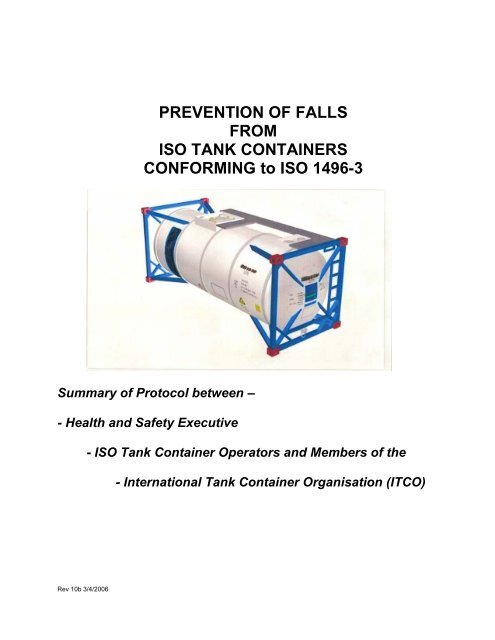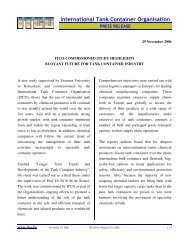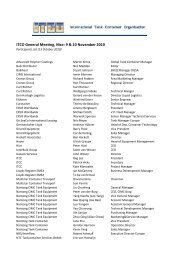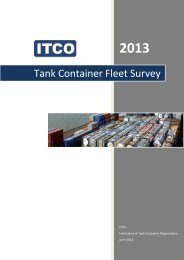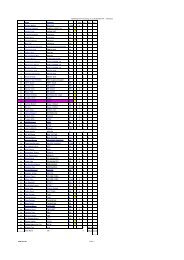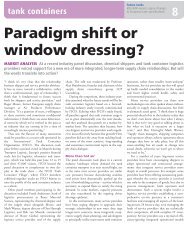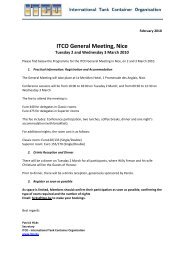Prevention of Falls From ISO Tank Containers - Itco.be
Prevention of Falls From ISO Tank Containers - Itco.be
Prevention of Falls From ISO Tank Containers - Itco.be
You also want an ePaper? Increase the reach of your titles
YUMPU automatically turns print PDFs into web optimized ePapers that Google loves.
Appendix A – Intermodal Supply Chain activities associated with <strong>ISO</strong> <strong>Tank</strong> <strong>Containers</strong>Rev 10 3
BACKGROUNDWhilst I T C O Group Mem<strong>be</strong>rs have experienced a small num<strong>be</strong>r <strong>of</strong> falls from height from <strong>ISO</strong>tank containers, the hazards associated with potential falls clearly dictate that the need for bothappropriate Safety Standards and Risk Management Procedures is a priority issue for all partiesin the loading, storage, repair, transportation, and unloading operations as identified above (seeAppendix A).This protocol whilst setting out to eliminate access by design acknowledges that this is a longtermsolution and for the interim period to 2013, it sets out the measures that should <strong>be</strong> takenalong with a timetable for doing so.The requirements and legal obligations for all intermodal supply chain (see diagram Appendix A)parties to conduct risk assessments <strong>of</strong> their operations, to reduce and/or eliminate risks, toprotect employees and related personnel, and to co-operate and co-ordinate their activities arewell established within the E U-based legislation.The protocol arrangements do not replace these obligations or duties. In so far as is reasonablypracticable, effective measures should <strong>be</strong> taken to prevent any person falling a distance likely tocause personal injury.Within these overall obligations and measures taken to minimise risk, a clear hierarchy <strong>of</strong> controlexists to guide this process:- To minimise/mitigate the need to access the tops <strong>of</strong> tank containers e.g. by developingbottom loading at discharge / receivers facilities.- Where access to the top <strong>of</strong> tank containers cannot <strong>be</strong> eliminated, ensure that fixedgantries are provided at loading, storage, repair, depot and discharge facilitiesincorporating secure all round protection on all sides <strong>of</strong> the high level working positionfrom which a person could fall.- In the event that load/deliveries are infrequent to places where fixed loading/unloading is notreasonably practicable and tank container top access cannot <strong>be</strong> eliminated then PORTABLEGANTRIES should <strong>be</strong> provided.- Use <strong>of</strong> fall arrest and restraint systems should primarily <strong>be</strong> seen as the last resort or used asan interim solution, pending application <strong>of</strong> the points above, and only if all <strong>of</strong> the previouscontrol measures are not reasonably practicable. Where the fall arrest/restraint system isused, rigorous controls and training measures need to <strong>be</strong> applied to support this method.(See Appendix B for hierarchy <strong>of</strong> control)THE WORKING PROTOCOLThe Protocol seeks to underpin the obligations descri<strong>be</strong>d above to minimise and mitigate therisks, with a set <strong>of</strong> practical actions which support the objectives <strong>of</strong> the I T C O <strong>Tank</strong> ContainerGroup Mem<strong>be</strong>rs. I T C O with other parties strive to continually improve Safety Standards acrossthe Intermodal supply chain and <strong>Tank</strong> Container Industry. Importantly, as well as describing theobligations <strong>of</strong> loading, storage, repair, depot and discharge facilities operations, the protocolprovides a timescale plan to improve physical controls applicable to tank container operators.Rev 10 4


